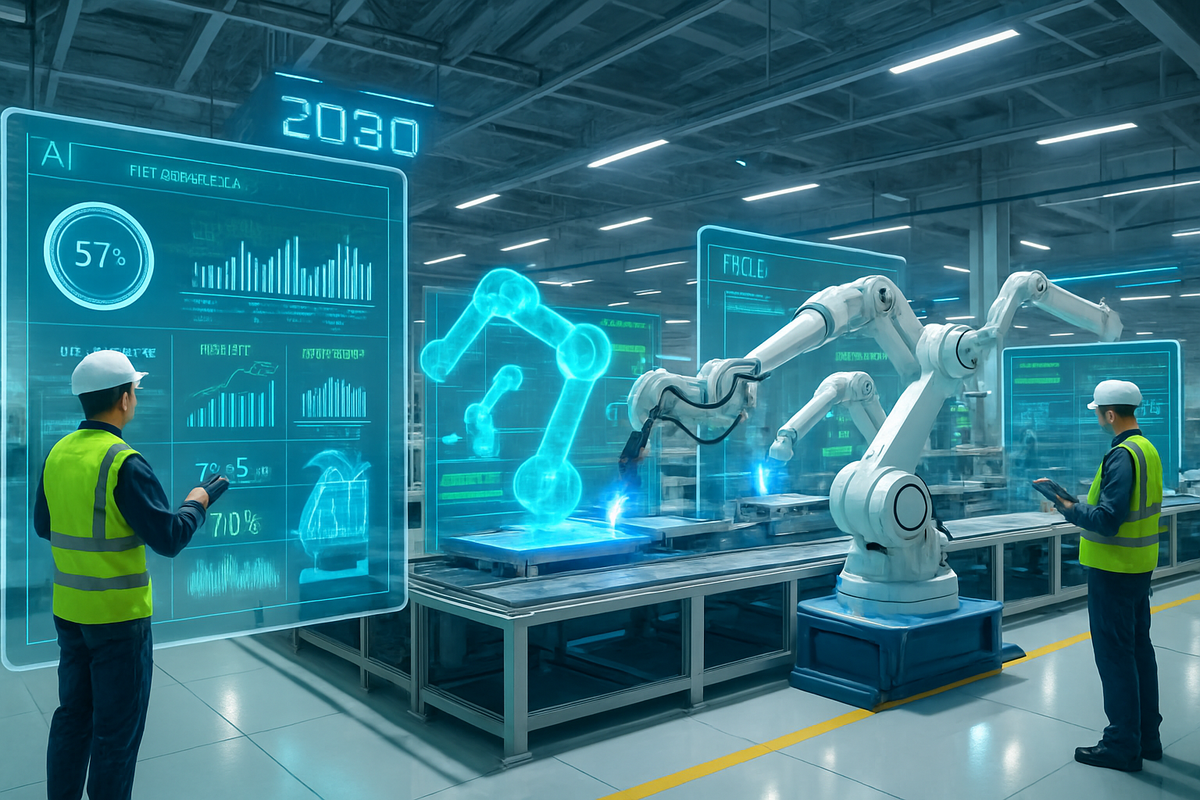The AI-Driven Factory of 2030: How Predictive Maintenance, Digital Twins, and Edge IoT Will Redefine Global Manufacturing
Step into the future of manufacturing with AI-powered smart factories—where machines predict failures, digital twins optimize processes, and edge IoT drives instantaneous decisions. Embrace the revolution before the future leaves you behind.

Welcome to 2030: The Age of the AI-Driven Smart Factory
Imagine a factory where machines whisper when they're about to break, digital twins run virtual rehearsals of tomorrow's production, and edge devices make split-second decisions before your morning coffee is even brewed. This isn't science fiction—it's the manufacturing reality of 2030, and it's coming faster than your last Amazon order.
“In 2030, smart factories won’t just make things—they’ll make decisions, too.”
The Three Pillars: Predictive Maintenance, Digital Twins, and Edge IoT
Let’s break down the triple threat powering this revolution:
- AI-Powered Predictive Maintenance (PdM): Forget scheduled downtime. AI analyzes streams of sensor data to forecast failures, so you fix only what’s needed, when it’s needed. Result? Up to 12% savings on maintenance costs and up to 50% less unplanned downtime, according to recent industry studies.
- Digital Twins: These virtual doppelgängers of your equipment and processes let you simulate, optimize, and troubleshoot before a wrench is ever turned. They’re not just digital mirrors—they’re crystal balls for your operations.
- Edge-Based IoT: Smart sensors and edge devices process data right on the factory floor, enabling real-time analytics and ultra-fast responses—no cloud lag, no bottlenecks, just pure industrial adrenaline.
How It All Comes Together: The Unified Smart Factory
In the AI-driven factory, these technologies don’t live in silos—they form an integrated nervous system that senses, thinks, and acts:
- IoT sensors continuously monitor vibration, temperature, pressure, and more.
- Edge AI crunches the numbers instantly, flagging anomalies before disaster strikes.
- Digital twins simulate fixes, predict outcomes, and optimize production schedules.
- Cloud platforms (think Azure, AWS, Siemens, IBM, GE Digital) unify data, train smarter AI, and orchestrate the whole show globally.
The Business Payoff: Not Just Tech for Tech’s Sake
What does this mean for manufacturers, supply chain leaders, and investors?
- Cost Savings: Companies embracing predictive maintenance and digital twins are reporting 30%+ reductions in equipment downtime and 10–20% lower maintenance costs.
- Operational Agility: Real-time analytics and simulation mean you can pivot production, reroute supply chains, or retool lines—often before competitors even spot a problem.
- Risk Mitigation: Early detection of faults, cyber threats, and supply chain hiccups keeps your factory humming (and your CFO smiling).
Real-World Case Studies: Smart Factories in Action
Here’s how leaders are already cashing in on this integrated approach:
- Rolls-Royce (Aerospace): By deploying IoT sensors and digital twins across its jet engine fleet, the company cut maintenance costs by 30% and improved reliability.
- ThyssenKrupp (Elevators): IoT-driven predictive maintenance boosted service reliability by 50%, slashing emergency call-outs and delighting building managers everywhere.
- Shell (Oil & Gas): Real-time sensor data and AI analytics reduced equipment downtime by 20%—a win for both profits and safety.
Cybersecurity: The Invisible Glue
No smart factory is complete without an iron-clad cybersecurity strategy. As IoT and AI multiply, so do the attack surfaces. Modern factories blend:
- Device authentication and end-to-end encryption
- Role-based access controls and continuous monitoring
- Regular firmware updates and security audits
The lesson: Your digital twin needs a digital bodyguard. Don’t skimp.
What About Jobs? Meet the New Industrial Workforce
Yes, automation is eliminating some repetitive tasks. But it’s also creating new, high-value roles:
- AI Maintenance Engineers—the diagnosticians of tomorrow’s machines
- Digital Twin Designers—part engineer, part simulation wizard
- Edge Computing Architects—the digital plumbers of distributed intelligence
- Industrial Data Scientists—because someone has to keep the AI honest
Pro tip: If you’re still using a clipboard, now’s a great time to upskill.
Best-in-Class Platforms & Solution Providers
Ready to future-proof your factory? These are the partner programs and platforms leading the charge in 2030:
- Siemens Digital Industries – End-to-end automation and digital twin solutions
- IBM Maximo – AI-infused enterprise asset management
- Azure IoT/AI & AWS Industrial AI – Scalable cloud and edge analytics
- GE Digital Predix – Industrial IoT and predictive analytics
- ABB Ability & Schneider Electric EcoStruxure – Smart automation and cybersecurity
- SAP Digital Manufacturing Cloud – Unified data and process orchestration
And yes, there’s a growing ecosystem of PdMaaS (Predictive Maintenance-as-a-Service) providers—perfect for manufacturers who want results, not a PhD in machine learning.
Actionable Insights: Your 2030 Factory Playbook
- Break down data silos. Integrate IT, OT, and IoT for a unified data platform.
- Invest in edge computing for real-time insights and ultra-low latency.
- Adopt digital twins to simulate, optimize, and de-risk operations before real-world changes.
- Automate cybersecurity—because smart factories attract smart threats.
- Upskill your workforce. The future belongs to those who can bridge the gap between machines and meaning.
“Predictive maintenance and digital twins aren’t just tech buzzwords—they’re the competitive advantage that will separate the disruptors from the disrupted.”
Subscribe, Comment, and Lead the Revolution
Want more smart news, career insights, and exclusive analysis on AI-powered manufacturing? Subscribe for free to our blog at Funaix Insider—and join a community where only subscribers can write and read comments. (It’s free, for now, but the future waits for no one!)
The AI-driven factory of 2030 is being built today—by bold leaders, curious tinkerers, and forward-thinking teams. Will you be part of the story, or just read about it?




